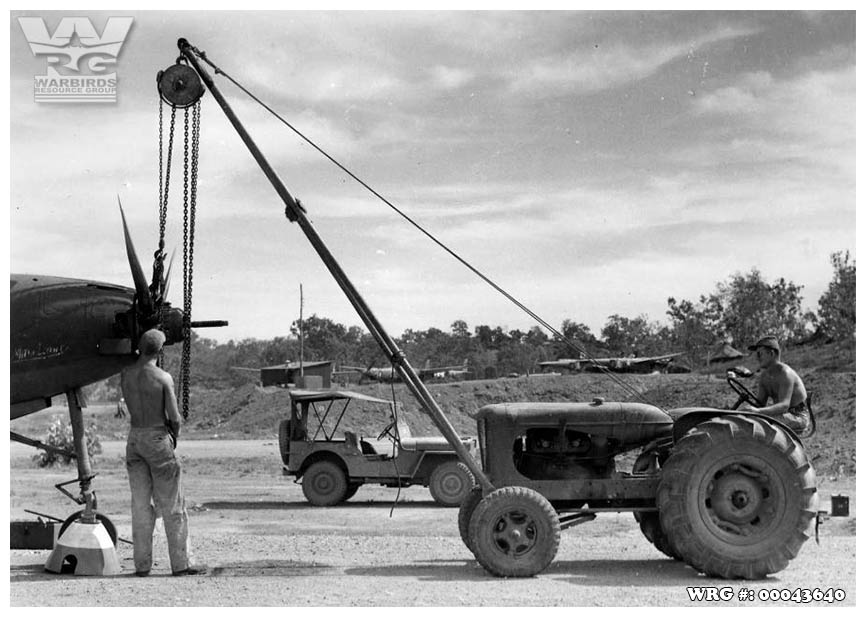Originally posted by Mark Allen
P-40 Warhawk of the 7th FS at 30 Mile strip

Walter Beane of the 39th FS/35th FG and his P-38 Lightning at 14 Mile strip.

P-38 Lightning of the 39th FS in a log revetment at 3 Mile strip

P-38H Lightning/42-66905/#33/Japanese Sandman II of the 39th FS at 14 Mile Strip. 1943.
(Source: Lt. Richard E. Smith via Mark Allen Collection)

P-38F Lightning/42-12652/#3, flown by 2nd Lt. Kenneth Sparks of the 39th FS at 14 Mile Strip. Photo was taken immediately following the December 31, 1942 mission in which a Ki-43 collided with the aircraft's right wing during a dogfight. Sparks was able to safely return to 14-Mile Drome ("Schwimmer Drome") and the aircraft would be repaired and reassigned to the 475th FG in early 1943, eventually being damaged beyond repair at Finschafen Airfield in early 1944, where it remained until it was discovered in the late 90's and recovered.
(Information from Pacific Wrecks)

P-38F Lightning/#27 of 39th FS.

Pilot Curran Jones of the 39th FS and his P-38 Lightning at 14 Mile airstrip, Port Moresby

Captain Robert Faroon, 20th January 1943

P-38 Lightnings of the 39th FS.

Bell P-39D-2-BE Airacobra/41-38499, damaged from collapsed gear at Milne Bay.

Bell P-39D-2-BE Airacobra/41-38499, wrecked at Milne Bay.

F5C Lightning of the 8th PRS, crashed at Tadji airstrip on the north coast of New Guinea

P-40N Warhawk of the 44th FS, crashed at Munda

P-40K Warhawk of the 7th FS/49th FG, bellied in at Dobodura

P-39 Airacobra gassing up at 30 Mile strip, Rarona

P-39 Airacobra having it's propeller removed, 27th Air Depot, Port Moresby

Looking down the Flightline Gurney Airstrip Milne Bay

P-38 Lightnings of the 80th FS taxi by on Cape Gloucester airstrip

F-4 Lightning/Eager Beaver II of the 8th PRS at 14 Mile airstrip, Port Moresby.

P-40 Warhawk of the 8th FS, after gear failure at Sorido airstrip, Biak

P-40 Warhawk of the 8th FS after suffering a gear failure, Sentani Strip

P-40E Warhawk of the 8th Fighter Squadron 'Black Sheep'/49th FG

P-40 Warhawk/Princess Pat II/129 of the 44th FS, Munda airstrip, December 1943.

P-40 Warhawks (42-105288 in the foreground) of the 35th FS/8th FG parked on an airstrip at Cape Gloucester, New Britain, February 6, 1944.

P-40 Warhawks on New Guinea

80th FS Pilot Ken Ladds P-38 at Dobodura airstrip Borio _15 Dobodura

Bell P-39N Airacobra/42-19027/Little Sir Echo.

Bell P-39Q Airacobras of the 82nd Recon Squadron, New Guinea, May 28, 1944.

P-39 Airacobras at Milne Bay

P-39 Airacobra being serviced in less than ideal conditions.
_________________
Scott Rose
Editor-In-Chief/Webmaster
Warbirds Resource Group - Warbird Information Exchange - Warbird Registry
Be civil, be polite, be nice.... or be elsewhere.-------------------------------------------------------
This site is brought to you with the support of members like you. If you find this site to be of value to you,
consider supporting this forum and the Warbirds Resource Group with a VOLUNTARY subscription
For as little as $2/month you can help ($2 x 12 = $24/year, less than most magazine subscriptions)
So If you like it here, and want to see it grow, consider helping out. Thanks to everyone who has so generously supported the site. We really do appreciate it.Follow us on Twitter! @WIXHQ
Thanks to everyone who has so generously supported the site. We really do appreciate it.Follow us on Twitter! @WIXHQ




